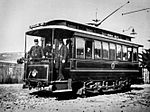Sydney Tram Classification
Steam trams of the 1880s and 1890s had separate numbers for motors and trailers within each separate system and the unified numbering scheme was not introduced for the electric tramcars until 1890.[1]
Classification
A statewide numbering scheme was required as isolated electric segments became joined and rolling stock interchanged and major maintenance performed at Randwick Tramway Workshops. In 1905 a general alphabetical classification was introduced to the NSW Government Tramways.
In general lettering indicated:
- A and B were given to steam stock
- C through to N (and later O, P and R) to electric cars based on seating capacity.
- T was planned for trailers but not displayed
- S indicated general service, non-passenger carrying stock
- U for ballast motors
- V for ballast trailers
- W for electric water sprinklers.
New types of electric trams continued to be allocated letters, with the exception of I, Q, Y and Z.
Classes
| Car Numbers and Classification | ||||
|---|---|---|---|---|
| Image | Numbers | Description | Class | |
 |
1-3 | Sydney's first Electric trams used for trial electrification on Randwick-Waverley and Military Road, North Sydney. Single truck end loading saloon car | Experimental cars | |
 |
4-97 | Single truck end loading saloon car | C-class (some T-class ) | |
 |
98-121 | Single truck, California combination, straight sill car | D-class | |
 |
122 | Maximum traction bogie California combination car, with straight chassis sill and longitudinal exterior seats (converted to L class, and later LP) | F-class | |
 |
123 | Single truck, California combination, straight sill car | D-class | |
 |
124-139 | Maximum traction bogie, half saloon, half open cross bench cars, with straight chassis sill and permanently coupled back to back | G-class | |
 |
140-288 | Maximum traction bogie California combination car, with straight chassis sill and longitudinal exterior seats (all cars converted to L class, and later LP) | F-class | |
 |
289-291 | Single truck end loading saloon car | C-class | |
 |
292,293 | ex-horse cars 199, 200 | T-class | |
 |
294 | Maximum traction bogie California combination car, with straight chassis sill and longitudinal exterior seats (converted to L class, and later LP) | F-class | |
 |
295 | Enclosed cross bench Maximum traction bogie car, partial centre-aisle when built | N-class | |
 |
296-395 | Maximum traction bogie California combination car, with straight chassis sill and longitudinal exterior seats (all cars altered to L class, and later LP, except No.393) | F-class | |
 |
396,397 | Single truck closed cross bench car, single ended, permanently coupled back to back in pairs. | E-class | |
 |
398-412 | Enclosed cross bench Maximum traction bogie car | N-class | |
 |
413 -612 | Single truck closed cross bench car, single ended, permanently coupled back to back in pairs. | E-class | |
 |
613-647 | Enclosed cross bench Maximum traction bogie car | N-class | |
 |
648-682 | Single truck, closed cross bench car | J-class | |
 |
683 | Enclosed cross bench Maximum traction bogie car (later Prison car N 948) | N-class | |
 |
684-728 | Enclosed cross bench Maximum traction bogie car (No. 704 converted to LP class) | N-class | |
 |
729-736 | ex-cable trailers | T-class | |
 |
737,738 | Maximum traction bogie open cross bench car | M-class | |
 |
739,740 | Single truck, open cross bench cars | H-class | |
 |
741- 745 | Single truck, closed cross bench car | J-class | |
 |
746-802 | Single truck cross bench, half open, half closed car | K-class | |
 |
803-805 | Single truck cross bench, half open, half closed car (destroyed before delivery) | K-class | |
 |
803-947 | Bogie cross bench, half open, half enclosed car (Nos. 855, 935, and 943 converted to O/P-Class) | O-class | |
 |
948 | Prison car | N-class | |
 |
949-1279 | Bogie cross bench, half open, half enclosed car (Nos. 961, 1007, 1089, 1170, and 1241 converted to O/P-class) | O-class | |
 |
1280-1329 | Single truck cross bench, half open, half closed car | K-class | |
 |
1330-1479 | Bogie cross bench, half open, half enclosed car (Nos. 1372, 1383, and 1451 converted to O/P-class) | O-class | |
 |
1480-1737 | Bogie enclosed cross bench car (Nos. 1517, 1562, 1573, and 1582 converted to PR1-class, No. 1691 converted to PR-class) | P-class | |
 |
1738-1932 | Front, centre and rear loading, bogie drop-centre saloon, divided into three compartments | R-class | |
 |
1933-2087 | Front, centre and rear loading drop centre bogie saloon car central body bulkheads | R1-class | |
References
- ^ McCarth & Chinn (1974). New South Wales Tramcar Handbook 1861-1961. SPER.
